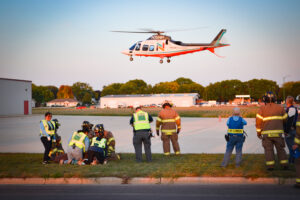Emergency Care
Emergency Care
 Sleepy Eye Medical Center is a designated Level Four trauma center by the Minnesota Statewide Trauma System of the Minnesota Department of Health. This designation verifies that our emergency department is trained and equipped to treat patients with minor to moderate injuries as well as stabilize and transfer seriously injured patients to a higher-level trauma center, when necessary.
Sleepy Eye Medical Center is a designated Level Four trauma center by the Minnesota Statewide Trauma System of the Minnesota Department of Health. This designation verifies that our emergency department is trained and equipped to treat patients with minor to moderate injuries as well as stabilize and transfer seriously injured patients to a higher-level trauma center, when necessary.
Ongoing training and the use of modern technology ensure that our emergency department staff is prepared to administer treatment for life-threatening conditions at any given time. Our helicopter pad provides convenient access for patients in need of air transportation.
Sleepy Eye Medical Center has physicians on call and readily available 24 hours a day, seven days a week. While we do not always have a physician on site, physicians who are on call are available at all times by telephone to respond and immediately assist as needed. Sleepy Eye Medical Center does provide fully-trained staff who are on site and available 24 hours a day. As outlined in the Emergency Medical Treatment and Active Labor Act (EMTALA), all patients who present to the Emergency Department will have a medical screening performed by a medical doctor.
What to Bring
Please bring your insurance card and driver’s license to each emergency department visit. We encourage you to carry this information in your wallet or purse so that it is always with you. Please bring all of your medications, including supplements, with you in their original bottles. It is very important that we know what medications you take.
What to Expect
The most convenient way to access our emergency department is through the northwest entrance. Emergency parking stalls are available near the emergency entrance. When you arrive, proceed to the nurse’s station to register. Interpreters are available for non-English speaking and hearing-impaired persons upon request.
Upon arrival, a nurse will take you to an emergency room, ask you a series of questions and assess your condition. A physician will be notified and arrive shortly. During your visit, the physician may order additional tests based on your condition. From there, our medical team will coordinate a care plan that best meets your needs. If advanced care is necessary, our team will arrange the appropriate form of transportation.
The following is a list of conditions typically treated in the emergency department:
- Abdominal pain
- Attempted suicide
- Burns, severe
- Bleeding, heavy
- Broken bones
- Chest pain
- Children under 3 months who need immediate care
- Difficulty breathing
- Extreme pain
- Head injury
- Large open wounds
- Loss of consciousness
- Severe or sudden headache (non-migraine)
- Spinal injuries
- Sudden change or loss in vision
- Sudden weakness or trouble talking
- Suspected poisoning
- Suspected overdose
*In the case of an emergency, please call 911.
The following is a list of conditions typically treated in the clinic:
- Allergies
- Back pain (not severe)
- Bladder infection
- Bug bite
- Burns, minor
- Chronic conditions
- Cold sore
- Cold symptoms
- Cough
- Cuts, small
- Diarrhea or vomiting
- Earache
- Fever
- Fractures, simple
- Gout
- Headache (not severe)
- Infections, minor
- Migraine headache
- Nasal congestion
- Physicals
- Pink eye
- Prenatal care, routine
- Poison ivy
- Rash
- Sinus issues
- Sore throat
- Sprain
- Strain
- Urinary tract infection
- Well-child visits
- Vaccinations
The lists above may not include every possible condition but are presented as a general guide to care. If in doubt about your treatment options, please call your healthcare provider. If it’s not urgent, we encourage you to schedule an appointment at your clinic. Your provider knows you and your health history and has access to your medical records. He or she can also provide follow-up care and make referrals, when necessary.
For information about our Sleepy Eye, Comfrey or Morgan Clinic—including locations, hours, services and scheduling—click here.
Level 1 Heart Attack Program
Level 1 Heart Attack Program
Sleepy Eye Medical Center is a designated Level 1 Heart Attack Program hospital. This program was developed by Abbott Northwestern Hospital and the Minneapolis Heart Institute to reduce the time to treatment for rural patients who suffer from heart attacks. Our emergency department staff is specially trained to quickly assess and identify the needs of cardiac patients and transfer those in need of advanced care to a facility that specializes in heart care by air transportation.